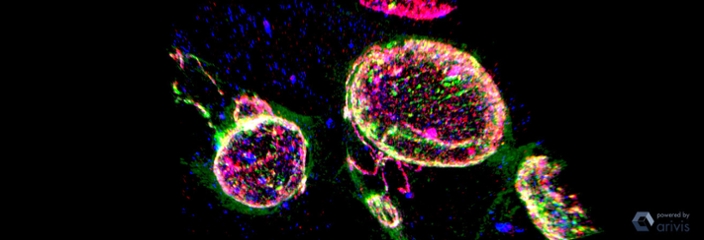
(See description under "Chlamydia Research Group")
Bacteriology
Our Bacteriology section is subcategorized into the Chlamydia Research Group, Coxiella Research, Staphylococcus Research, Training in Pathometabolism and Tularemia Research.
The Chlamydia Research Group involves three highly specialized researchers. Drs. Rey Carabeo, Scot Ouellette and Elizabeth "Lisa" Rucks are well trained within the field of Chlamydia biology. Each scientist has separate research projects. The Carabeo Lab is conducting work on the interaction of the human pathogen Chlamydia trachomatis with the mucosal epithelium. The Ouelette Lab is focused on the consequences of reductive evolution on bacterial physiology while the Rucks Lab studies why Chlamydia love lipids! (Image above: Super resolution 3D image of a fluorescently labeled chlamydial inclusion containing Chlamydia trachomatis transformed with a plasmid encoding IncA-APEX2, infected onto a HeLa cell monolayer. The red fluorescence is labeling IncA-APEX2, pink indicating endogenous IncA, green is labeling biotinylated proteins, and blue are chlamydial organisms within the inclusion.)
Our Coxiella burnetii research is being conducted by Stacy Gilk, PhD. The goal of Gilk's lab is to understand how Coxiella survives in the host cell, and identify new therapeutic targets. Coxiella burnetii causes Q fever endocarditis, a disease that requires 18-24 months of antibiotic treatment and lacks an FDA-approved vaccine. The goal of our research is to understand how Coxiella survives in the host cell, and identify new therapeutic targets. During infection, Coxiella infects macrophages and survives in a unique, lysosomal-like compartment called the Coxiella Containing Vacuole (CCV). CCV formation is essential for bacterial survival, yet we know little about CCV biogenesis and maintenance. We are especially interested in how cholesterol and other lipids contribute to CCV formation and the unique properties of the CCV.
Staphylococcus research within this department is led by Kenneth Bayles, PhD and funded by a P01 grant from the NIH. The group includes Drs. Paul Fey, Tammy Kielian, Vinai Thomas and Marat Sadykov. Each researcher is focused and working on different aspects of developing novel antibiotics and therapeutic strategies to combat infections caused by S. aureus and S. epidermidis. This group of scientists are also part of the Center for Staphylococcal Research (CSR). At the CSR, education and training using the latest, innovative technology are high priorities. The CSR is the first in the nation dedicated to staphylococcal research and translational treatment strategies. We are utilizing a team approach of practitioners and researchers to lessen the impact of staphylococcal disease on human health.
We have a Training in Pathometabolism program geared to postdoctoral trainees that offers broad-based training that combines molecular, cell biological, immunological, and metabolism to investigate comprehensively mechanisms of disease caused by bacteria and their interactions with the host. The primary goal is to produce well-trained scientists to address the future needs of infectious disease research in academic, industrial or government settings.
Our Tularemia Research is led by Marilynn Larson, MSc, PhD. Dr. Larson’s research is focused on elucidating the molecular mechanisms that allow intracellular pathogens to evade the immune system and persist. Her research involves highly infective strains that are among the most pathogenic bacteria known with the potential to be used as a bioweapon, therefore are classified as Tier 1 select agents by the Centers of Disease Control and Prevention.

